1998 OPEL FRONTERA Electrical
[x] Cancel search: ElectricalPage 2307 of 6000
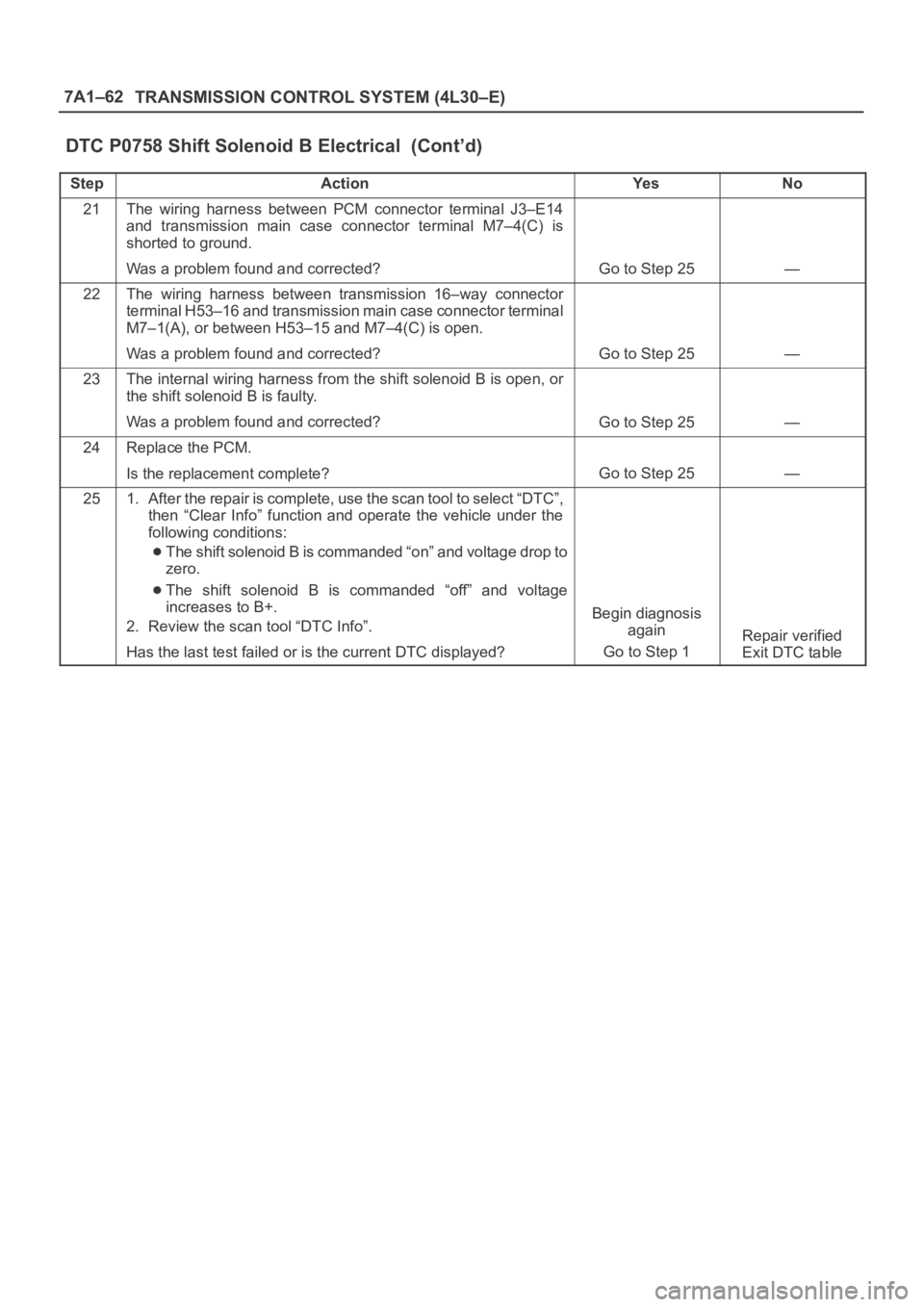
7A1–62
TRANSMISSION CONTROL SYSTEM (4L30–E)
DTC P0758 Shift Solenoid B Electrical (Cont’d)
StepNo Ye s Action
21The wiring harness between PCM connector terminal J3–E14
and transmission main case connector terminal M7–4(C) is
shorted to ground.
Was a problem found and corrected?
Go to Step 25—
22The wiring harness between transmission 16–way connector
terminal H53–16 and transmission main case connector terminal
M7–1(A), or between H53–15 and M7–4(C) is open.
Was a problem found and corrected?
Go to Step 25—
23The internal wiring harness from the shift solenoid B is open, or
the shift solenoid B is faulty.
Was a problem found and corrected?
Go to Step 25—
24Replace the PCM.
Is the replacement complete?
Go to Step 25—
251. After the repair is complete, use the scan tool to select “DTC”,
then “Clear Info” function and operate the vehicle under the
following conditions:
The shift solenoid B is commanded “on” and voltage drop to
zero.
The shift solenoid B is commanded “off” and voltage
increases to B+.
2. Review the scan tool “DTC Info”.
Has the last test failed or is the current DTC displayed?
Begin diagnosis
again
Go to Step 1
Repair verified
Exit DTC table
Page 2312 of 6000

TRANSMISSION CONTROL SYSTEM (4L30–E)7A1–67
DTC P1850 Brake Band Apply Solenoid Malfunction
D07RW009
Circuit Description
The brake band apply solenoid is a normally open
solenoid which controls the flow of fluid for brake band
application. The Powertrain Control Module (PCM)
uses Pulse Width Modulation (PWM) and changes
the duty cycle to control the solenoid. The PCM turns
the solenoid on (energized) and off (deenergized) at a
constant frequency. The length of time the solenoid is
energized during each on/off cycle is called the pulse
width. By varying or “modulating” the pulse width, the
solenoid output pressure is changed. Since the
solenoid is normally open, increasing the pulse width
increases the duty cycle and decreases the output
pressure. PWM control provides smooth band
application without an accumulator. The band is only
applied in first and second gears.
In the event of an electrical failure (open), the
solenoid regulates at the maximum oil flow (0% duty
cycle).
The solenoid is activated by current. This current is
produced by applying a voltage to one side (the High
side) and a ground to the other side (Low side).
The High Side Driver (HSD) is a circuit of the PCM
that acts as a switch between the solenoids and the
supply voltage. The High side of the solenoid is
permanently supplied with voltage. When the ignition
is off, the HSD is turned off.This DTC detects a continuous open or short to ground in
the brake band apply solenoid circuit or the brake band
apply solenoid. This is a type “D” DTC.
Conditions For Setting The DTC
Battery voltage is between 10 and 16 volts.
Ignition is “on”, Engine “run”.
The PCM commands the solenoid “on” and the
voltage remains high (B+) or the PCM commands the
solenoid “off” and the voltage remains low (zero
volts).
All conditions met in 1.3 seconds.
Action Taken When The DTC Sets
Inhibit brake band apply solenoid.
The PCM will not illuminate the CHECK TRANS
Lamp.
Conditions For Clearing The DTC
The DTC can be cleared from the PCM history by
using a scan tool.
The DTC will be cleared from history when the vehicle
has achieved 40 warmup cycles without a failure
reported.
The PCM will cancel the DTC default actions when
the fault no longer exists and the ignition is cycled “off”
long enough to power down the PCM.
Page 2313 of 6000
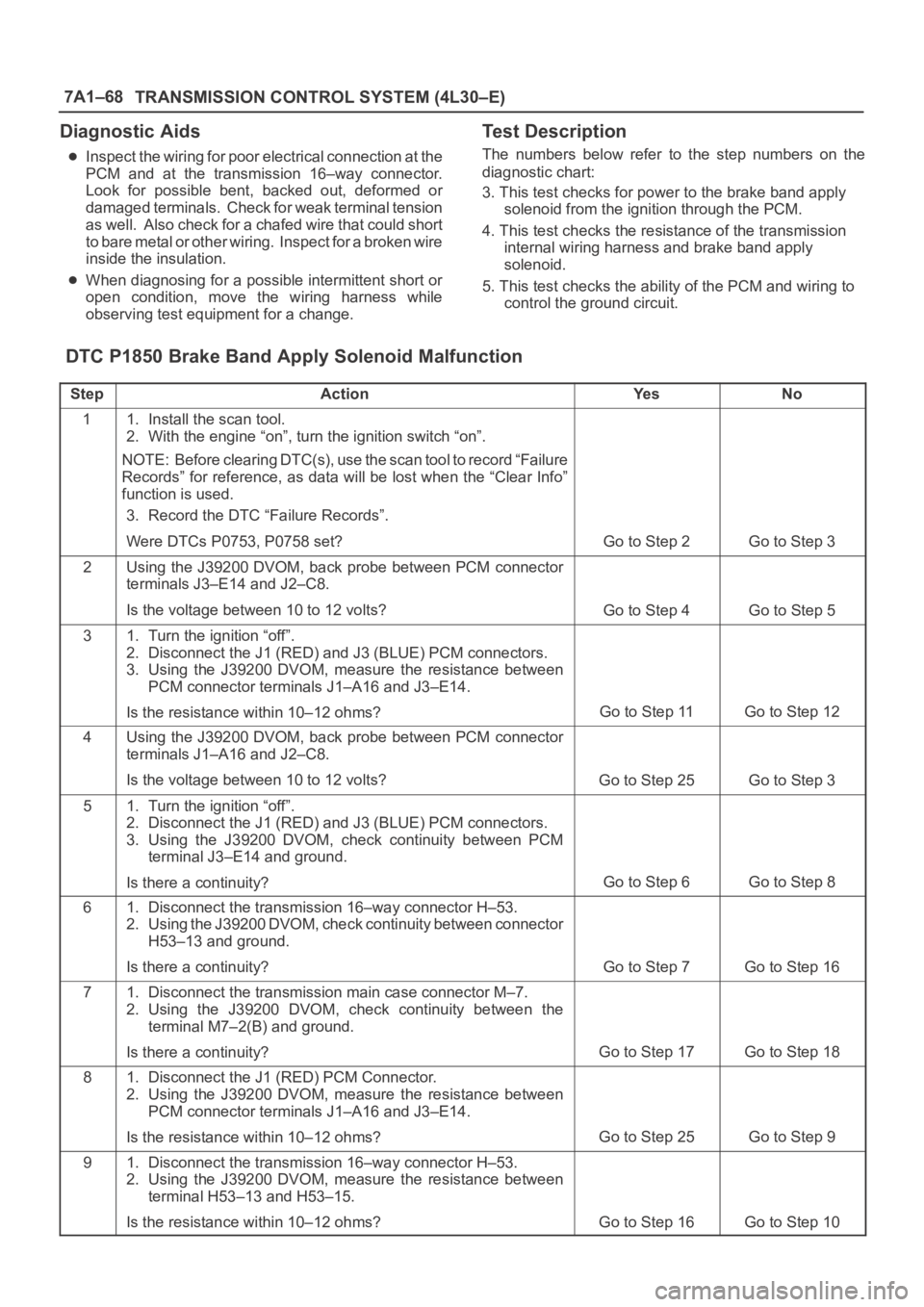
7A1–68
TRANSMISSION CONTROL SYSTEM (4L30–E)
Diagnostic Aids
Inspect the wiring for poor electrical connection at the
PCM and at the transmission 16–way connector.
Look for possible bent, backed out, deformed or
damaged terminals. Check for weak terminal tension
as well. Also check for a chafed wire that could short
to bare metal or other wiring. Inspect for a broken wire
inside the insulation.
When diagnosing for a possible intermittent short or
open condition, move the wiring harness while
observing test equipment for a change.
Test Description
The numbers below refer to the step numbers on the
diagnostic chart:
3. This test checks for power to the brake band apply
solenoid from the ignition through the PCM.
4. This test checks the resistance of the transmission
internal wiring harness and brake band apply
solenoid.
5. This test checks the ability of the PCM and wiring to
control the ground circuit.
DTC P1850 Brake Band Apply Solenoid Malfunction
StepActionYe sNo
11. Install the scan tool.
2. With the engine “on”, turn the ignition switch “on”.
NOTE: Before clearing DTC(s), use the scan tool to record “Failure
Records” for reference, as data will be lost when the “Clear Info”
function is used.
3. Record the DTC “Failure Records”.
Were DTCs P0753, P0758 set?
Go to Step 2Go to Step 3
2Using the J39200 DVOM, back probe between PCM connector
terminals J3–E14 and J2–C8.
Is the voltage between 10 to 12 volts?
Go to Step 4Go to Step 5
31. Turn the ignition “off”.
2. Disconnect the J1 (RED) and J3 (BLUE) PCM connectors.
3. Using the J39200 DVOM, measure the resistance between
PCM connector terminals J1–A16 and J3–E14.
Is the resistance within 10–12 ohms?
Go to Step 11Go to Step 12
4Using the J39200 DVOM, back probe between PCM connector
terminals J1–A16 and J2–C8.
Is the voltage between 10 to 12 volts?
Go to Step 25Go to Step 3
51. Turn the ignition “off”.
2. Disconnect the J1 (RED) and J3 (BLUE) PCM connectors.
3. Using the J39200 DVOM, check continuity between PCM
terminal J3–E14 and ground.
Is there a continuity?
Go to Step 6Go to Step 8
61. Disconnect the transmission 16–way connector H–53.
2. Using the J39200 DVOM, check continuity between connector
H53–13 and ground.
Is there a continuity?
Go to Step 7Go to Step 16
71. Disconnect the transmission main case connector M–7.
2. Using the J39200 DVOM, check continuity between the
terminal M7–2(B) and ground.
Is there a continuity?
Go to Step 17Go to Step 18
81. Disconnect the J1 (RED) PCM Connector.
2. Using the J39200 DVOM, measure the resistance between
PCM connector terminals J1–A16 and J3–E14.
Is the resistance within 10–12 ohms?
Go to Step 25Go to Step 9
91. Disconnect the transmission 16–way connector H–53.
2. Using the J39200 DVOM, measure the resistance between
terminal H53–13 and H53–15.
Is the resistance within 10–12 ohms?
Go to Step 16Go to Step 10
Page 2316 of 6000
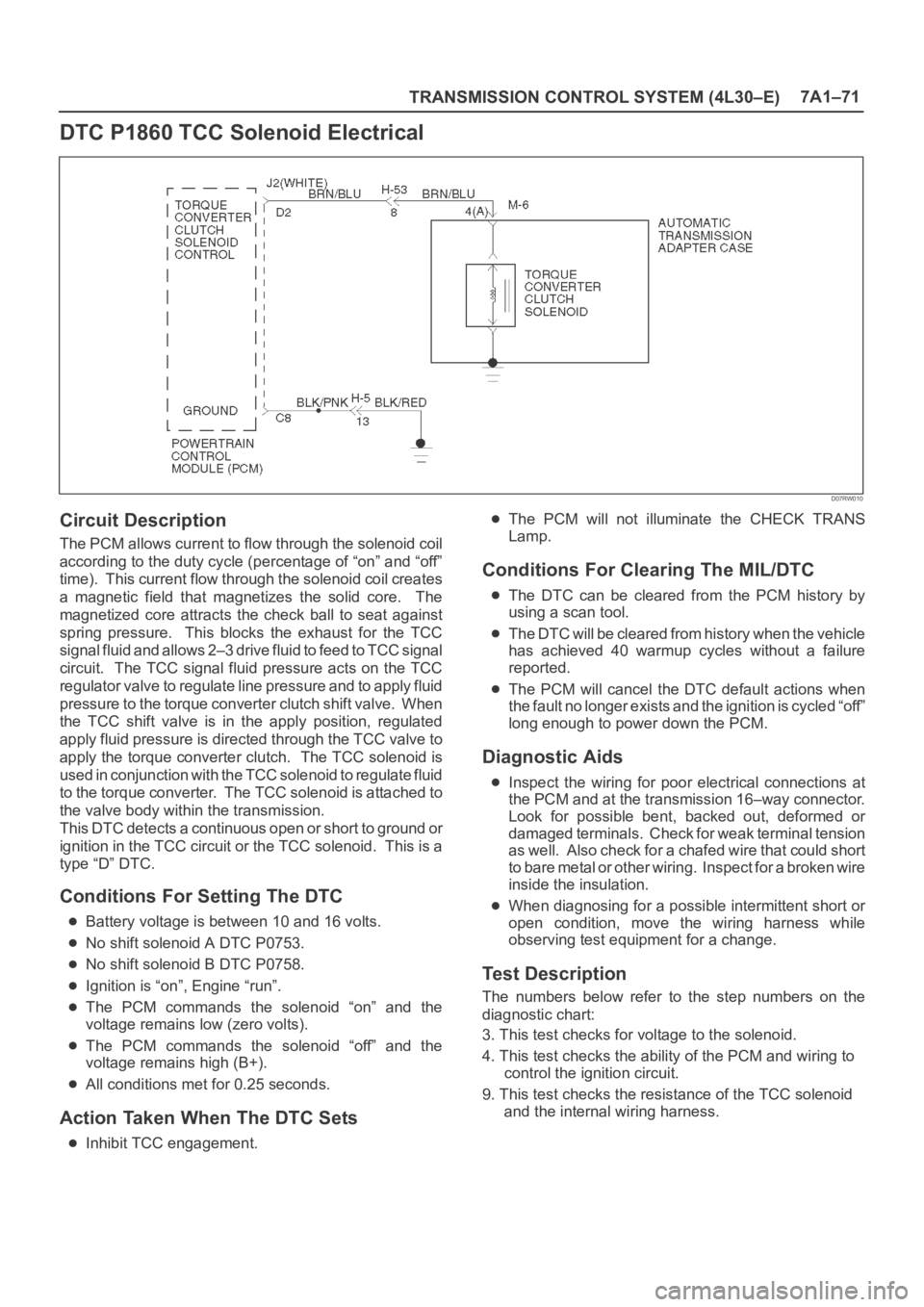
TRANSMISSION CONTROL SYSTEM (4L30–E)7A1–71
DTC P1860 TCC Solenoid Electrical
D07RW010
Circuit Description
The PCM allows current to flow through the solenoid coil
according to the duty cycle (percentage of “on” and “off”
time). This current flow through the solenoid coil creates
a magnetic field that magnetizes the solid core. The
magnetized core attracts the check ball to seat against
spring pressure. This blocks the exhaust for the TCC
signal fluid and allows 2–3 drive fluid to feed to TCC signal
circuit. The TCC signal fluid pressure acts on the TCC
regulator valve to regulate line pressure and to apply fluid
pressure to the torque converter clutch shift valve. When
the TCC shift valve is in the apply position, regulated
apply fluid pressure is directed through the TCC valve to
apply the torque converter clutch. The TCC solenoid is
used in conjunction with the TCC solenoid to regulate fluid
to the torque converter. The TCC solenoid is attached to
the valve body within the transmission.
This DTC detects a continuous open or short to ground or
ignition in the TCC circuit or the TCC solenoid. This is a
type “D” DTC.
Conditions For Setting The DTC
Battery voltage is between 10 and 16 volts.
No shift solenoid A DTC P0753.
No shift solenoid B DTC P0758.
Ignition is “on”, Engine “run”.
The PCM commands the solenoid “on” and the
voltage remains low (zero volts).
The PCM commands the solenoid “off” and the
voltage remains high (B+).
All conditions met for 0.25 seconds.
Action Taken When The DTC Sets
Inhibit TCC engagement.
The PCM will not illuminate the CHECK TRANS
Lamp.
Conditions For Clearing The MIL/DTC
The DTC can be cleared from the PCM history by
using a scan tool.
The DTC will be cleared from history when the vehicle
has achieved 40 warmup cycles without a failure
reported.
The PCM will cancel the DTC default actions when
the fault no longer exists and the ignition is cycled “off”
long enough to power down the PCM.
Diagnostic Aids
Inspect the wiring for poor electrical connections at
the PCM and at the transmission 16–way connector.
Look for possible bent, backed out, deformed or
damaged terminals. Check for weak terminal tension
as we ll. A lso ch eck fo r a ch af e d w ire th at cou l d s ho r t
to bare metal or other wiring. Inspect for a broken wire
inside the insulation.
When diagnosing for a possible intermittent short or
open condition, move the wiring harness while
observing test equipment for a change.
Test Description
The numbers below refer to the step numbers on the
diagnostic chart:
3. This test checks for voltage to the solenoid.
4. This test checks the ability of the PCM and wiring to
control the ignition circuit.
9. This test checks the resistance of the TCC solenoid
and the internal wiring harness.
Page 2317 of 6000
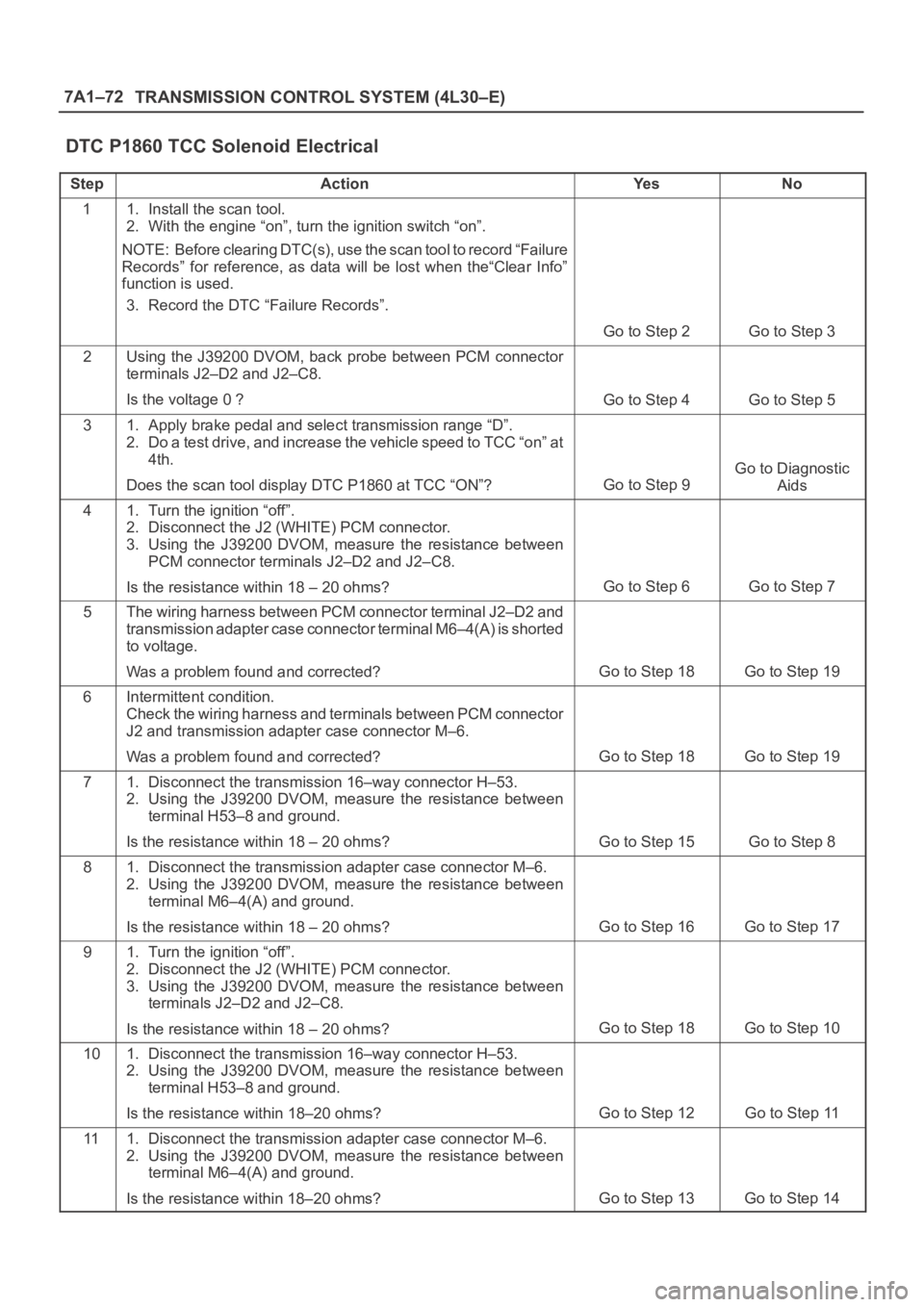
7A1–72
TRANSMISSION CONTROL SYSTEM (4L30–E)
DTC P1860 TCC Solenoid Electrical
StepActionYe sNo
11. Install the scan tool.
2. With the engine “on”, turn the ignition switch “on”.
NOTE: Before clearing DTC(s), use the scan tool to record “Failure
Records” for reference, as data will be lost when the“Clear Info”
function is used.
3. Record the DTC “Failure Records”.
Go to Step 2Go to Step 3
2Using the J39200 DVOM, back probe between PCM connector
terminals J2–D2 and J2–C8.
Is the voltage 0 ?
Go to Step 4Go to Step 5
31. Apply brake pedal and select transmission range “D”.
2. Do a test drive, and increase the vehicle speed to TCC “on” at
4th.
Does the scan tool display DTC P1860 at TCC “ON”?
Go to Step 9
Go to Diagnostic
Aids
41. Turn the ignition “off”.
2. Disconnect the J2 (WHITE) PCM connector.
3. Using the J39200 DVOM, measure the resistance between
PCM connector terminals J2–D2 and J2–C8.
Is the resistance within 18 – 20 ohms?
Go to Step 6Go to Step 7
5The wiring harness between PCM connector terminal J2–D2 and
transmission adapter case connector terminal M6–4(A) is shorted
to voltage.
Was a problem found and corrected?
Go to Step 18Go to Step 19
6Intermittent condition.
Check the wiring harness and terminals between PCM connector
J2 and transmission adapter case connector M–6.
Was a problem found and corrected?
Go to Step 18Go to Step 19
71. Disconnect the transmission 16–way connector H–53.
2. Using the J39200 DVOM, measure the resistance between
terminal H53–8 and ground.
Is the resistance within 18 – 20 ohms?
Go to Step 15Go to Step 8
81. Disconnect the transmission adapter case connector M–6.
2. Using the J39200 DVOM, measure the resistance between
terminal M6–4(A) and ground.
Is the resistance within 18 – 20 ohms?
Go to Step 16Go to Step 17
91. Turn the ignition “off”.
2. Disconnect the J2 (WHITE) PCM connector.
3. Using the J39200 DVOM, measure the resistance between
terminals J2–D2 and J2–C8.
Is the resistance within 18 – 20 ohms?
Go to Step 18Go to Step 10
101. Disconnect the transmission 16–way connector H–53.
2. Using the J39200 DVOM, measure the resistance between
terminal H53–8 and ground.
Is the resistance within 18–20 ohms?
Go to Step 12Go to Step 11
111. Disconnect the transmission adapter case connector M–6.
2. Using the J39200 DVOM, measure the resistance between
terminal M6–4(A) and ground.
Is the resistance within 18–20 ohms?
Go to Step 13Go to Step 14
Page 2318 of 6000
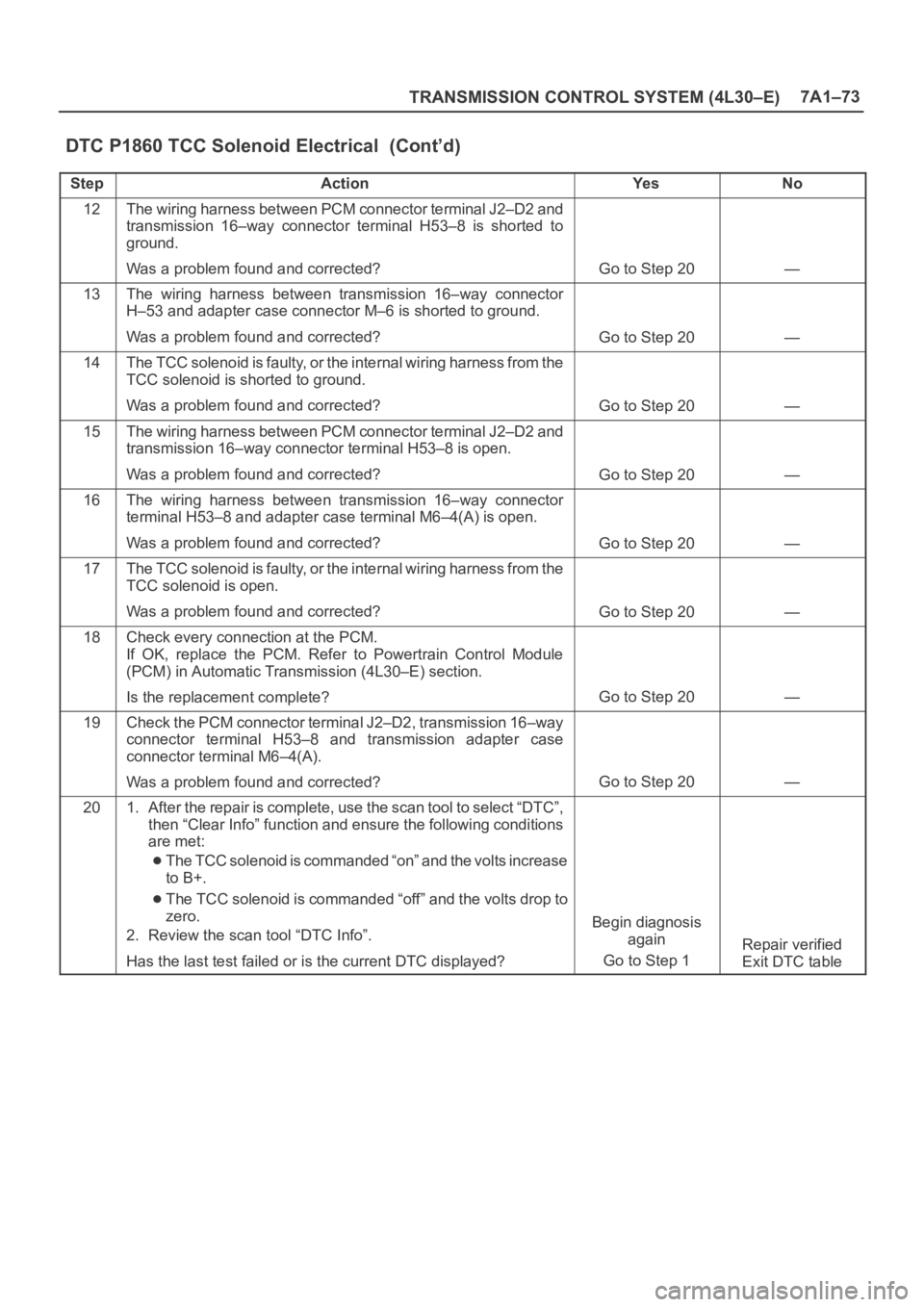
TRANSMISSION CONTROL SYSTEM (4L30–E)7A1–73
DTC P1860 TCC Solenoid Electrical (Cont’d)
StepNo Ye s Action
12The wiring harness between PCM connector terminal J2–D2 and
transmission 16–way connector terminal H53–8 is shorted to
ground.
Was a problem found and corrected?
Go to Step 20—
13The wiring harness between transmission 16–way connector
H–53 and adapter case connector M–6 is shorted to ground.
Was a problem found and corrected?
Go to Step 20—
14The TCC solenoid is faulty, or the internal wiring harness from t h e
TCC solenoid is shorted to ground.
Was a problem found and corrected?
Go to Step 20—
15The wiring harness between PCM connector terminal J2–D2 and
transmission 16–way connector terminal H53–8 is open.
Was a problem found and corrected?
Go to Step 20—
16The wiring harness between transmission 16–way connector
terminal H53–8 and adapter case terminal M6–4(A) is open.
Was a problem found and corrected?
Go to Step 20—
17The TCC solenoid is faulty, or the internal wiring harness from t h e
TCC solenoid is open.
Was a problem found and corrected?
Go to Step 20—
18Check every connection at the PCM.
If OK, replace the PCM. Refer to Powertrain Control Module
(PCM) in Automatic Transmission (4L30–E) section.
Is the replacement complete?
Go to Step 20—
19Check the PCM connector terminal J2–D2, transmission 16–way
connector terminal H53–8 and transmission adapter case
connector terminal M6–4(A).
Was a problem found and corrected?
Go to Step 20—
201. After the repair is complete, use the scan tool to select “DTC”,
then “Clear Info” function and ensure the following conditions
are met:
The TCC solenoid is commanded “on” and the volts increase
to B+.
The TCC solenoid is commanded “off” and the volts drop to
zero.
2. Review the scan tool “DTC Info”.
Has the last test failed or is the current DTC displayed?
Begin diagnosis
again
Go to Step 1
Repair verified
Exit DTC table
Page 2597 of 6000
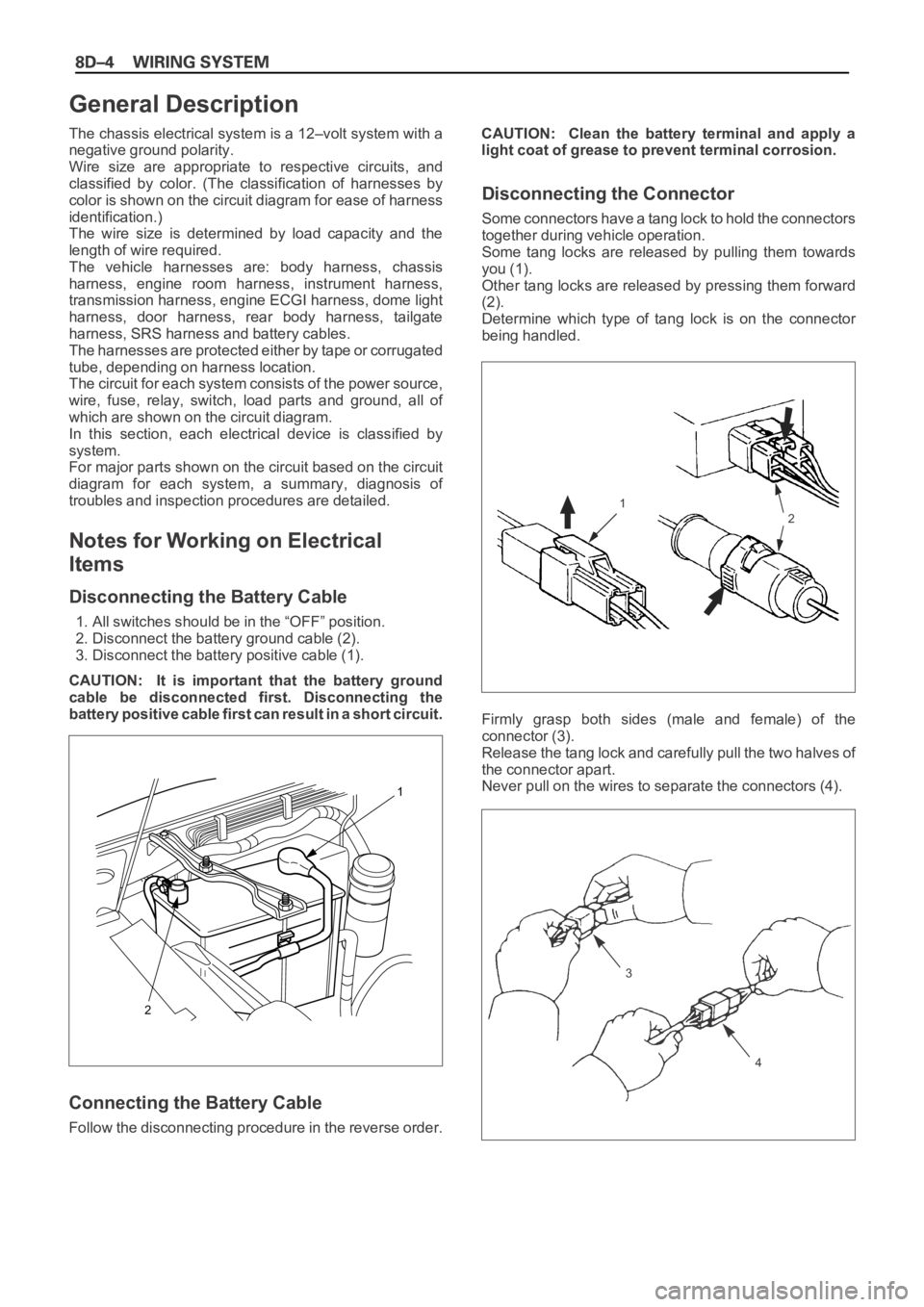
The chassis electrical system is a 12–volt system with a
negative ground polarity.
Wire size are appropriate to respective circuits, and
classified by color. (The classification of harnesses by
color is shown on the circuit diagram for ease of harness
identification.)
The wire size is determined by load capacity and the
length of wire required.
The vehicle harnesses are: body harness, chassis
harness, engine room harness, instrument harness,
transmission harness, engine ECGI harness, dome light
harness, door harness, rear body harness, tailgate
harness, SRS harness and battery cables.
The harnesses are protected either by tape or corrugated
tube, depending on harness location.
The circuit for each system consists of the power source,
wire, fuse, relay, switch, load parts and ground, all of
which are shown on the circuit diagram.
In this section, each electrical device is classified by
system.
For major parts shown on the circuit based on the circuit
diagram for each system, a summary, diagnosis of
troubles and inspection procedures are detailed.
Notes for Working on Electrical
Items
Disconnecting the Battery Cable
1. All switches should be in the “OFF” position.
2. Disconnect the battery ground cable (2).
3. Disconnect the battery positive cable (1).
CAUTION: It is important that the battery ground
cable be disconnected first. Disconnecting the
battery positive cable first can result in a short circuit.
Connecting the Battery Cable
Follow the disconnecting procedure in the reverse order.CAUTION: Clean the battery terminal and apply a
light coat of grease to prevent terminal corrosion.
Disconnecting the Connector
Some connectors have a tang lock to hold the connectors
together during vehicle operation.
Some tang locks are released by pulling them towards
you (1).
Other tang locks are released by pressing them forward
(2).
Determine which type of tang lock is on the connector
being handled.
Firmly grasp both sides (male and female) of the
connector (3).
Release the tang lock and carefully pull the two halves of
the connector apart.
Never pull on the wires to separate the connectors (4).
2
1
General Description
1
2
3
4
Page 2600 of 6000
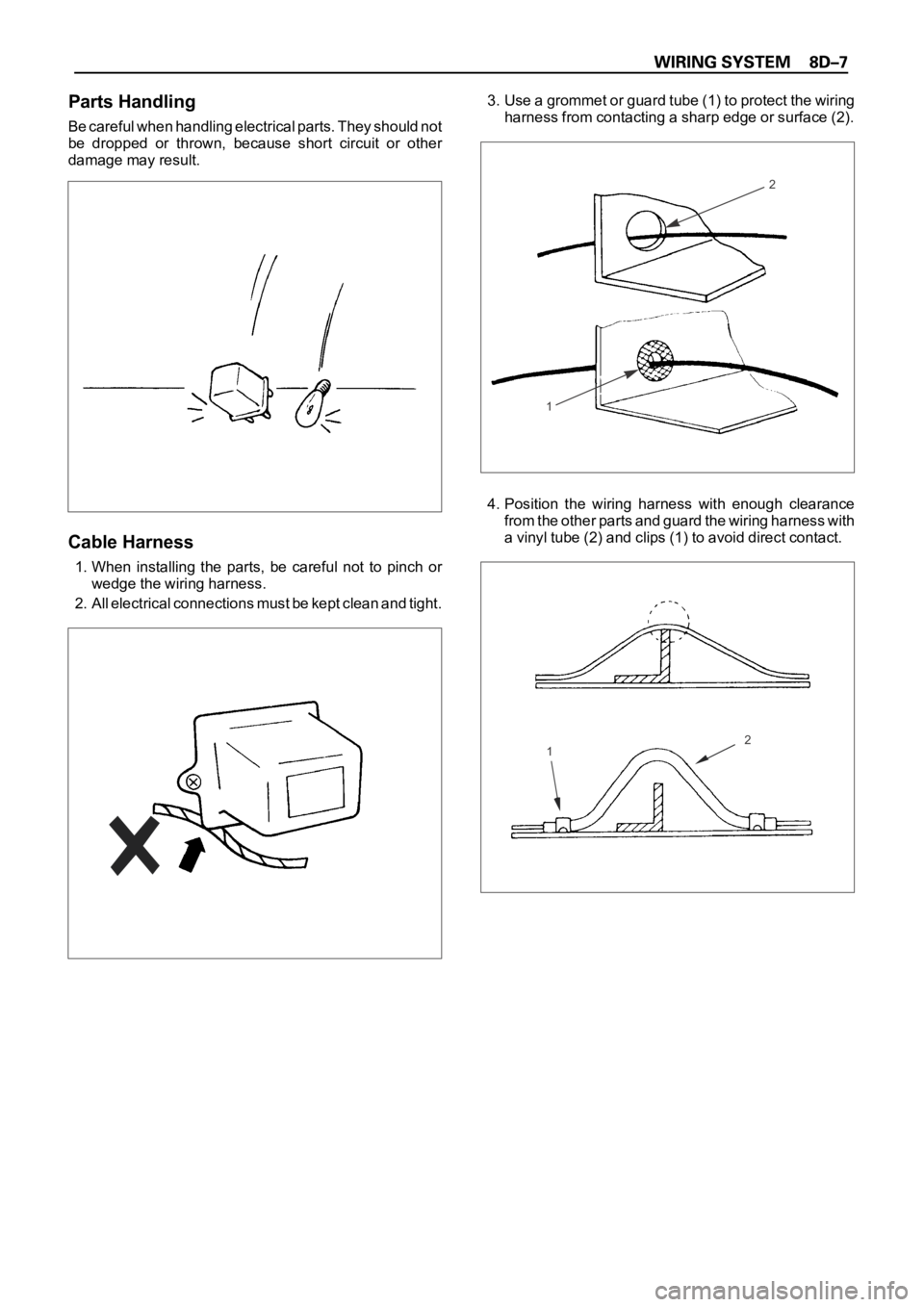
Parts Handling
Be careful when handling electrical parts. They should not
be dropped or thrown, because short circuit or other
damage may result.
Cable Harness
1. When installing the parts, be careful not to pinch or
wedge the wiring harness.
2. All electrical connections must be kept clean and tight.3. Use a grommet or guard tube (1) to protect the wiring
harness from contacting a sharp edge or surface (2).
4. Position the wiring harness with enough clearance
from the other parts and guard the wiring harness with
a vinyl tube (2) and clips (1) to avoid direct contact.
12
2
1